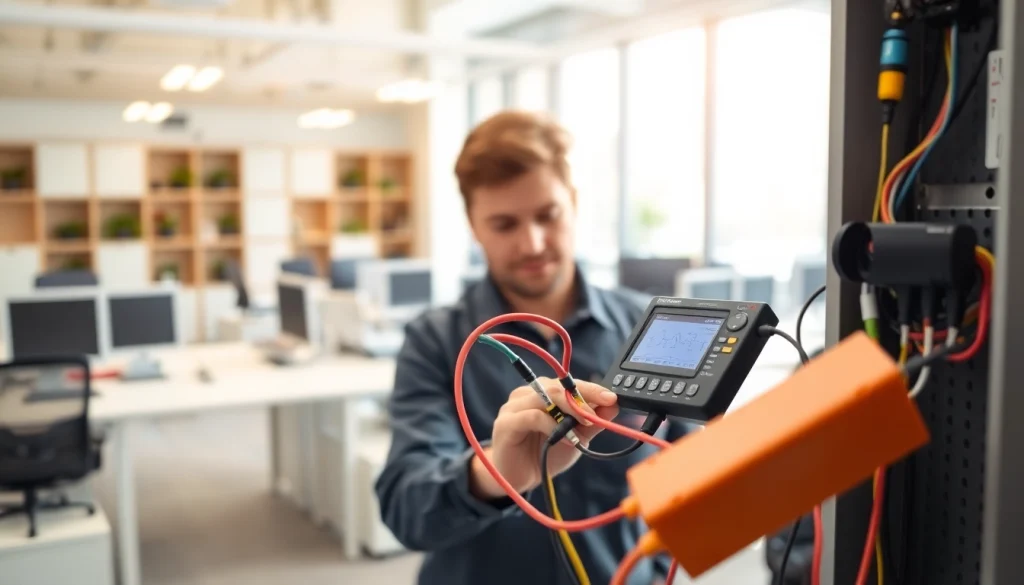Ensuring Safety: A Comprehensive Guide to Portable Appliance Testing

Understanding Portable Appliance Testing
What is Portable Appliance Testing?
Portable Appliance Testing (PAT) is a critical process used primarily in the UK and several other countries to ensure that electrical appliances are safe for use. The focus of PAT is to perform routine checks on portable appliances, which include devices that can be moved and are powered by electricity, such as computers, kettles, and power tools. These checks involve two key processes: visual inspections and electrical testing. Portable Appliance Testing follows regulations and standards set by various health and safety organizations to minimize risks associated with electrical hazards.
The Importance of PAT in Electrical Safety
The significance of PAT cannot be overstated in environments where electrical equipment is used regularly. Conducting PAT helps organizations identify potential safety risks, which can lead to severe consequences such as electrical fires, injuries, or fatalities. Furthermore, non-compliance with PAT regulations can result in legal challenges, including hefty fines and civil liabilities. By ensuring all portable appliances are tested and maintained, employers can safeguard their workforce and minimize operational risks.
Key Terminology and Concepts in PAT
Understanding PAT involves familiarizing with several key terms and concepts:
- Insulation Resistance: This measures the resistance of the insulation of the appliance, crucial for preventing electrical shocks.
- Earth Continuity: Ensures that the earth connection is effective, allowing for safe discharge of electricity.
- Class I and Class II Appliances: Class I appliances are earthed devices, while Class II appliances have double insulation and don’t require earthing.
- Visual Inspection: The first step in PAT involves checking the physical condition of the appliance for wear and tear.
- Test Labels: These labels indicate when an appliance was last tested and when it is due for retesting.
Legal Obligations and Standards for Portable Appliance Testing
UK Regulations on PAT Compliance
In the UK, several regulations govern the compliance of electrical safety, including PAT. The Health and Safety at Work Act 1974 obligates employers to ensure, as far as reasonably practicable, the safety of all employees in the workplace. The Electricity at Work Regulations 1989 also emphasize the necessity of proper maintenance of electrical equipment, thus reinforcing the importance of regular PAT. Failure to adhere to these regulations can lead to severe penalties, highlighting the need for organizations to implement robust PAT protocols.
International Standards for Electrical Appliance Testing
Globally, PAT practices may differ, but many countries adhere to similar electrical safety standards. For instance, the International Electrotechnical Commission (IEC) develops and publishes international standards. Additionally, countries like Australia have their own guidelines, such as AS/NZS 3760:2010, which outlines the inspection and testing of electrical equipment. Understanding these diverse standards is essential for organizations operating in multiple countries.
Understanding Employer Responsibilities
Employers are tasked with ensuring compliance with both local and international regulations regarding electrical safety. This responsibility extends to conducting regular PAT on their equipment, documenting inspections, and addressing any electrical hazards promptly. Having a PAT policy in place is crucial, as it serves to not only protect employees but also uphold the organization’s reputation and operational integrity.
Best Practices for Effective Portable Appliance Testing
Choosing the Right Testing Equipment
Selecting appropriate testing equipment is paramount for accurate PAT. Various testing devices like multifunction testers can execute several tests in one go, simplifying the process. The decision on equipment should be informed by factors such as the type of appliances tested and the specific tests required for compliance. Investing in high-quality PAT testers ensures reliability and can improve the efficiency of the testing process.
Steps for Conducting a Thorough PAT
Conducting effective PAT requires a systematic approach. Here are essential steps in the process:
- Initial Visual Inspection: Check for any visible damage or wear on the appliance and the plug.
- Record Keeping: Document the serial number, location, and condition of appliances prior to testing.
- Testing Procedure: Utilize testing equipment to check insulation resistance, earth continuity, and other relevant tests.
- Label Each Appliance: After successful testing, label appliances with test dates and due dates for the next test.
- Final Reporting: Compile all records and create a report summarizing the results and any corrective actions needed.
Documenting and Reporting PAT Results
Ensuring comprehensive documentation of test results not only aids in tracking compliance but also provides vital information for audits. It’s important to establish a standardized reporting format that includes details of each test, results, and any corrective actions taken. This documentation should be readily accessible and maintained for a minimum of five years, aligning with typical regulatory requirements.
Common Challenges in Portable Appliance Testing
Identifying Common Electrical Hazards
Every PAT process must prioritize hazard identification. Common issues include frayed wires, damaged plugs, and failure to meet local regulations. A proactive approach to recognizing these hazards can prevent accidents and ensure safety compliance. Regular training and updates for staff on the significance of electrical safety will reinforce this priority.
Dealing with Non-Compliance Issues
Non-compliance with PAT regulations may lead to serious consequences, including penalties and increased liability. To combat this, organizations must implement a structured PAT program that includes regular audits and reviews. These programs should promote a culture of safety, where employees feel responsible and empowered to report concerns regarding electrical safety.
Training Requirements for PAT Technicians
Proper training for technicians conducting PAT is vital to the success of any testing program. Technicians should undergo training to understand electrical safety principles, operation of testing equipment, and compliance regulations. Continuous professional development ensures that they are updated with the latest best practices and technologies in the field.
Future Trends in Portable Appliance Testing
Technological Advances in PAT Equipment
The landscape of PAT equipment is continually evolving with advancements in technology. Newer devices not only perform multiple tests more efficiently but also allow for data logging and digital reporting capabilities. The integration of software that can produce instant reports and schedule re-test dates has streamlined the PAT process significantly, saving valuable time and resources.
Impact of IoT on Portable Appliance Safety
As the Internet of Things (IoT) continues to grow, its impact on the safety and maintenance of electrical appliances cannot be overlooked. IoT devices can monitor appliance performance in real-time, alerting users to potential faults before they escalate into safety hazards. This proactive approach can significantly reduce incidents and enhance the overall safety of electrical appliances.
The Role of Automation in PAT Processes
Automation is a key trend shaping the future of PAT. Facilities are increasingly adopting automated systems that conduct tests, document results, and notify management of compliance statuses. This enhances efficiency, reduces human error, and provides better insights into appliance safety trends over time.







